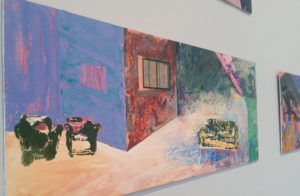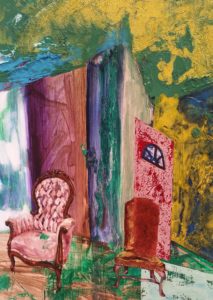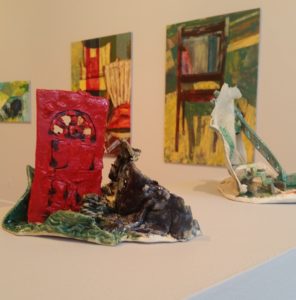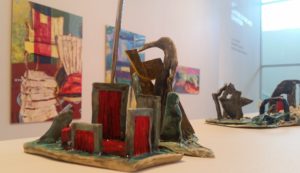This interview is an exercise in shape-shifting, in movement and transition. We are all furniture, and we can defy space and time.
It started with a visit to the Schmidt Center Gallery for The 2016 MFA Exhibition at Florida Atlantic University in Boca Raton. I approached the gallery’s glass doors and open myself to the possibilities of art. I didn’t make any demands of the white and pale gray walls, the splashes of color from carefully installed paintings, the promise of other work around corners, or the obtrusive curtain hanging from the ceiling in the back of the space. On the wall as I entered, the artists’ names welcomed me in a simple font, but the work of one artist in particular went well beyond that. Well beyond simple.
Artist Khaulah Naima Nuruddin’s exhibition, Allusions, challenged me, inspired me, held me, and pushed me away. I know I was open to the possibilities of art, but I wasn’t prepared for the emotional journey Nuruddin’s work demanded. I didn’t consider the possibility of being snatched from my present and thrust into memories of heartache and loneliness to be rescued by color and hope and the beauty of survival.

Allusions is a trip. A heavy one. Yet leaving the gallery, I felt more alive and present in my own body, in my own space, than I had when I entered. There was a hunger. Both literal and figurative.
Then just like that we’re at Burger House, a local Boca Raton burger joint. The soundtrack? Jazz standards featuring up-tempo trumpet blasts and tinkling piano. The eats? More tower than sandwich, half an avocado, lettuce, tomato, and onions piled high atop a juicy brisket burger. The beer is cold and crisp. The artist, in a cool cotton V-neck and jeans, is smiling and gracious, laid back and thoughtful.
I barely know where to start. Khaulah suggests we start at the beginning.
SLG: You started out in your academic artistic career, and by this I mean your BFA from University of South Florida, with painting your lovers. This carried over to the beginning of your graduate work at FAU as well, then the work took on an interesting change. Describe the transition of your work from then to now.
KNN: Before I determined that an academic education could benefit my art practice I was painting the female figure. As a so-called “outsider” artist, my work included stylized female forms situated in non-representational spaces. My intention at that time was to use my work to express how it feels to be a woman in an environment where her freedom of expression is stifled. As I moved through the BFA program at USF, I continued to paint the figure in order to engage in the same conversation, but I stopped relying solely on my imagination and started to include source material; images from collages I had made, photos of interior spaces, and my partner as my model. I was using an actual woman to represent a theoretical woman. It was not until I became emotionally and intellectually immersed in creating my MFA thesis work that I discovered that my relationship with the woman I used as a model had an effect on how I painted the figure.
SLG: So, your relationship with your lover as your model began to affect how that lover was portrayed in the work? How did you first notice that was happening?
KNN: In one of my relationships, my partner and I were not getting along and it became difficult for me to complete the paintings with her as the model. Being unsatisfied in that relationship was reflected in the way I painted her. She once told me that a preparatory drawing for a painting I was planning, using her image, looked like an alien creature. I said, “What? No, she looks like you.” She did not receive that image or my artistic interpretation of her very well. I solved this problem by removing the human figure from the work. I allowed the chair she might sit in to represent her. This solution was perfect because it meant that I do not have to a woman to make the work that is important to me.
SLG: That discovery led to the space around the lover-figure taking center stage. Did you embrace that transition in your work?
KNN: When the “background” in my work started to pull my interest from rendering the figure, I didn’t really take the time to consciously process the origin of that shift. I simply allowed myself to enjoy exploring texture and color relationships. I excitedly welcomed this change by taking a few weeks to focus on playing with the materials I had in my studio, but had not taken the time to understand. I let myself have actual fun with layering paint and mediums, allowing them to cure, peeling off the skin before they were able to cure, and adding even more layers. It was a concentrated time of pure fun in the midst of working through my MFA program, which I took very seriously. Transitioning to tending to the ground with as much care as I do the figure was natural and fluid because while I was exploring the textures that would serve my work I was spending time painting studies of chairs. Eventually, the textural studies married the furniture studies in an unexpected way that touched my emotional self.
SLG: As a result of this shift, and the new ways you were using paint and mediums, and maybe even with this new emotional aesthetic in the work, suddenly furniture—beds, stools, chairs—become these really emotionally charged symbols. How were you able to make a chair an emotional being, get them to stand in for your lovers, and in some cases yourself? How does a stool feel sadness or loneliness? How does a damn chair resign with frustration?
KNN: This was the most challenging aspect of resolving the Allusions paintings. I knew I had the technical skill to paint a believable chair or chaise lounge, but I needed to anthropomorphize the furniture piece so that the viewer could receive the experience of the lover-figure, now removed. You are correct, Sheree, furniture does stand in for the women involved, my lover and me. When I engage in problem solving the most successful way to present this alternative figure, I start with the story I want to tell then think about what type of chair the person is, in that moment. If I am the person to be painted I ask myself “What kind of chair am I in this moment?”
SLG: “What kind of chair am I in this moment” is not a common question to ask, especially not in response to romantic relationships. When things are emotionally difficult, I might find myself looking for escape routes and not so much contemplating whether I am a wingback dining room chair or overstuffed recliner. (Note: After the Boca Burger get down, I’d definitely be more overstuffed La-Z-Boy). In terms of escape routes though, you expound on your work and its use of doors and windows by writing, “I like the idea of assisting the uninvited by giving her more than one option, should the door be impenetrable.” What do you mean here?
KNN: Options equal hope. I think of the doors and windows as openings, portals through which one can pass through to access different states of being. I feel that all of us have these portals. Some people have more points of access due to their willingness to be vulnerable.
SLG: Vulnerability. That’s something many people, myself included, struggle to navigate. How does this vulnerability relate to the recurring image of the red door in your work?

KNN: I do not prefer vulnerability. The red door is a symbolic tool for gauging emotional availability, the level of vulnerably we are willing to trust another with. As I mature, I have had many different relationships—romantic and otherwise—that have taught me to guard my emotional self in various ways. If I keep my red door closed, I get to protect my sensitive parts. Windows can be entryways that allow people to touch the sensitive parts because windows are openings that are not as secure as doors. This can be good or terrible. When I choose to be closed, I don’t have the pleasure of feeling like someone who really knows me can actually care about me. On the other hand, when I am open and vulnerable, I allow another the space to hurt me. I do not prefer to suffer, but being alone is another kind of suffering.
SLG: You illustrate this suffering in the most provocative of ways in Allusions. The colors are at once bold and expressive, yet the symbols seem to whisper through their position and solitude. How intentional was this contrast?
KNN: The pretty colors serve as a distraction. There is something sad and real about this body of work that is hidden by the exuberant color I use. My color choices/combinations are thoughtfully determined using a self-made key for emotional states of being. When there is green there is the fullness of love, orange is representative of anxiety and the darkest of blues equal acceptance.
SLG: You were also able to translate this contrast to three dimensional, ceramic art. Why include ceramics in this collection?

KNN: When I looked through some of my preliminary sketches, I could visualize them having another dimension. Translating the visual vocabulary appealed to me because this meant that the viewer could have a physical interaction with the psychological space I create. The ceramic structures give the viewer access to both sides of the door or window because there is not an inside/outside dynamic, nothing is hidden from the viewer, so they can be at once a part of the piece and apart from the piece.
SLG: Do you feel a connection to one more than the other, the paintings more than the ceramics or vice versa?
KNN: I am a painter. I love paint, and it is my first love. I enjoy the smell of the oils and the mediums that allow the properties of the paint to be so varied. One of the things I appreciate about the process I have for paintings is that when pouring, and scraping the material there are surprises that I don’t always control. There is room for the happy accident.
SLG: Like the white dude with the afro? Happy little accidents turn into trees?
KNN: Haha, Yes! Bob Ross. I recently noticed that his show is on Netflix. I’m not really a fan of formulaic landscape painting, but I am a VERY big fan of Bob Ross and his luxurious afro . There is a quote of his that I love, it goes something like, “There’s nothing more scary than touching your brush, for the first time, to a big ole white canvas.” When making something to share with others, whether it be a painting or a meal I want, I want for it to be well-received. But like any edible dish, it’s unreasonable for me to expect that all people will love the art I make. Allowing the accident to happen is liberating. It’s nice to have those unplanned elements in the work. It keeps it fresh and alive.

When working with clay and glaze in the expressive way I do, there are many unplanned results that lead to the final structure. I have learned to be less precious about the object when making ceramic pieces, and this has helped me release some of my need for control when I am working through my oil paintings.
SLG: With what you’re learning about yourself and your work, you’ve identified what you call a sort of “visual vocabulary.” Will you build upon this vocabulary or use the existing vocabulary to create your next work?
KNN: My next work is already in the works. You should see my home and studio, there are in-progress paintings everywhere. I am both using and building on the existing visual vocabulary. I have in-progress paintings that relate very closely to my thesis work, focusing on the chair as figure, using portals and heightened color to suggest an emotional state of being. I also have works in progress that bring back the actual human figure to relate to the textural, color specific skewed perspective space I am currently in love with.
SLG: Where can we find out more about you and your work?
KNN: Seeing is believing. It really is. There is nothing like standing close to a work of art and really seeing it. Some of what I do can be captured with a camera, but my artwork needs to be seen in person. So, If you want to find out more about my work you have to SEE it. If you have access to the ocean side of South Florida, Allusions is still up for viewing at The 2016 MFA Exhibition at Florida Atlantic University , in the Schmidt Center Gallery in Boca Raton. The closing date for that show has been extended to August 1st 2016. Also, I have a couple of pieces in the Intersectionality exhibition at MOCA, in Miami, opening June 23rd. If you are not able to come experience the work in person, you can always check out my website for updated images or to connect with me to find out about upcoming exhibitions: www.khaulahnaima.com
SLG: Well, I saw the work, so I can definitely cosign the viewing as an experience. Yet, we’ve also been able to learn so much about you and your work through this discussion. And that’s how I see art most times, a discussion, an exchange. So, before we close, is there anything else you’d like to add about art and love and life and the dopeness of visual language?
KNN: Though I use personal experiences to fuel my image making, it is important to understand that anyone can relate their personal stories to the visual elements in my painted works and ceramic structures. This work is about solitude, extreme caring, upset, fear, and frustration. I make this variety of art because I understand the concepts involved and I have something to share that adds to the conversation; a new way of looking at how it feels to feel.
SLG: Take us out with three jams you’ve been riding out to in between gallery installations.
KNN: Yo Gotti “It Goes Down in the DM”, Joss Stone’s “What Were We Thinking”, and “Win Again” by Nicki Minaj.
Khaulah Naima Nuruddin, originally from Milwaukee, WI, received her BFA from University of South Florida then continued her studies at Florida Atlantic University, where she earned her MFA. Nuruddin’s work uses symbolic imagery and anthropomorphized objects to explore the sensitivities of emotionally charged human interaction. Based out of Fort Lauderdale, Nuruddin is a working artist who also serves as Museum Education Coordinator at her alma mater, FAU. Find out more about her work at www.khaulahnaima.com.
Sheree L. Greer hosts Oral Fixation, the longest running LGBTQ Open Mic series in Tampa Bay, teaches writing and literature at St. Petersburg College, and started The Kitchen Table Literary Arts Center to showcase and support the work of ancestor, elder, and contemporary women writers of color. Her published work includes the short story collection, Once and Future Lovers, two novels, Let the Lover Be and A Return to Arms, and various essays, interviews, and short stories found both online and in print. Learn more about Sheree and her work at www.shereelgreer.com and www.kitchen-table.org.

